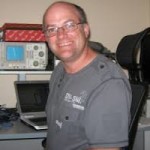Posts Tagged ‘battery’
 LHS Episode #149: Coming Up Lemons
LHS Episode #149: Coming Up Lemons
 Hello again, and welcome to Episode #149 of Linux in the Ham Shack. In this episode we tackle a number of interesting and diverse topics: Starting with Field Day and an online course on Climate Change, we move to software patent legislation, deep topics like buildroot and custom Linux images, and then to hardware reverse engineering for your benefit and a utility for helping you save battery power on your laptop. We even manage to get in an interview with our ambassador to SELF, Darrell, KI4LLA. Don't miss one action-packed second.
Hello again, and welcome to Episode #149 of Linux in the Ham Shack. In this episode we tackle a number of interesting and diverse topics: Starting with Field Day and an online course on Climate Change, we move to software patent legislation, deep topics like buildroot and custom Linux images, and then to hardware reverse engineering for your benefit and a utility for helping you save battery power on your laptop. We even manage to get in an interview with our ambassador to SELF, Darrell, KI4LLA. Don't miss one action-packed second.
73 de The LHS Guys
 LHS Episode #138: Being David Rowe
LHS Episode #138: Being David Rowe
 How about that: It's the first episode of Linux in the Ham Shack for 2015! We hope everyone is having a great new year so far. In this episode, we talk with David Rowe, VK5DGR, of Adelaide, South Australia. David is an audio engineer, Ph.D. scholar, inventor of Codec2 and co-author of FreeDV, among his many accolades. We talk to David about his projects, Linux, amateur radio, life in Australia, LinuxConf AU, the new SM1000 FreeDV device, the amount of energy it takes to make a Krispy Kreme donut, home built electric cars, and much more. Until next time...
How about that: It's the first episode of Linux in the Ham Shack for 2015! We hope everyone is having a great new year so far. In this episode, we talk with David Rowe, VK5DGR, of Adelaide, South Australia. David is an audio engineer, Ph.D. scholar, inventor of Codec2 and co-author of FreeDV, among his many accolades. We talk to David about his projects, Linux, amateur radio, life in Australia, LinuxConf AU, the new SM1000 FreeDV device, the amount of energy it takes to make a Krispy Kreme donut, home built electric cars, and much more. Until next time...
73 de The LHS Guys
 New method to produce graphene may lead to a revolution in battery technology
New method to produce graphene may lead to a revolution in battery technology
This is a small article I wrote for our office newsletter. Major implications for portable Amateur Radio equipment and emergency communications.
Batteries. They have become a huge part of our everyday lives. Think of how many devices we use that need to be recharged regularly. Cell Phones, iPads, laptops, digital cameras, cordless vacuums, electric razors, and now cars too. Tesla and other pioneers in the electric car industry are slowly moving toward technology that resolves a lot of the capacity issues in their devices, with some models now reaching a 300 mile range. The iPhone has become another great example of what engineering can do for battery capacity, with newer models able to go for a day or more between charges with normal use. Capacity is no longer the issue it once was. Charging time is now what’s holding battery technology back in applications like cars, industrial machinery, and tools. Even using one of the Tesla Superchargers takes about 30 minutes to charge a Tesla S to 50 percent capacity, and most cell phones still take an hour or more for a full charge.
The answer to this problem may lie in a substance called graphene. Graphene was invented in 2010 at the University of Manchester, UK. The two scientists who came up with the process were awarded the Nobel Prize in Physics. Graphene is a single layer of carbon, forming a thin sheet, one molecular layer thick, and has amazing properties both physically and electrically. Graphene is extremely conductive, and shows promise in the field of electronics, helping to create faster and smaller semi-conductors, as well as many other practical uses.
The original method to create graphene is extremely low-tech, and not very practical. The Scientists at the University of Manchester were able to pull a single layer of carbon molecules off of a piece of graphite by using Scotch Tape. This proves to be impractical on a large scale though, and a new method was needed. Last year at UCLA, researchers found a way to make graphene out of graphite oxide dispersed in water using low powered lasers. The lasers they used however, were the ones in an ordinary DVD burner. By coating a DVD with graphite oxide, and burning it on the label side using LiteScribe technology, they were able to create sheets of graphene, opening the door to a cheap method of creating this substance.
The real surprise came when one of the researchers attached a square of graphene to a light bulb, and managed to keep it lit for 5 minutes, after a charge time of only a few seconds. What they had stumbled on, was a new way of creating something called a super capacitor. Capacitors store electricity like batteries do, but charge and discharge rapidly, sometimes many times a second. A super capacitor combines the properties of both a battery and a capacitor, giving us a component that can charge rapidly, but behave like a battery once charged.
Thanks to the new method of creating graphene, this technology is closer to reality than most. Imagine being able to recharge device in seconds instead of minutes or hours. The possibilities this brings to the computer and auto industries are fantastic. It also opens up the idea of cordless, rechargeable devices to a host of new industries. Keep an eye on this, as it is going to change the way we look at portable devices, and energy storage.
 LHS Episode #040: HF in the Mobile Shack
LHS Episode #040: HF in the Mobile Shack
 It’s a couple of days since the end of the 2010 Dayton Hamvention. Cheryl and I would like to send out a special thank you to everyone who stopped by our booth while we were there. We met a lot of interesting folks and had a great many thought provoking conversations. It was our first time so we didn’t know we’d be out in the sticks, so to speak, but we still had a lot of traffic and a lot of fun.
It’s a couple of days since the end of the 2010 Dayton Hamvention. Cheryl and I would like to send out a special thank you to everyone who stopped by our booth while we were there. We met a lot of interesting folks and had a great many thought provoking conversations. It was our first time so we didn’t know we’d be out in the sticks, so to speak, but we still had a lot of traffic and a lot of fun.
Now that I’m home and most of the work that piled up on me while I was away has been tackled, I got the podcast we recorded before the event finished and here it is. There’s no Dayton content this time around. That will come next time. The drawing for the Alinco radio and the other Linux in the Ham Shack swag will happen on Friday and we’ll announce all the winners in the next show and on the Web site so stay tuned for that. In the meantime, enjoy some interesting feedback from listeners and some insight into Richard’s latest mobile rig install. Keep the feedback coming, visit our Printfection and Cafe Press stores and pick up an item or two, and get ready for next year in Dayton. Linux in the Ham Shack will be back.
73 de The LHS Guys













